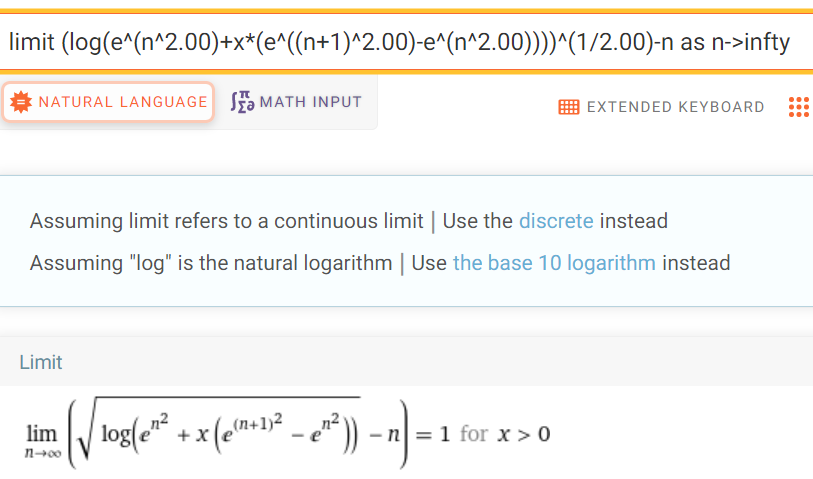The brackets denote the fractional part function. It is well known that the distribution (defined as the limit of the empirical distribution) is $F(x)=(e^x - 1)/(e-1)$, with $x\in [0, 1]$, if $\alpha=1$, see here. Also, $\{n^\alpha\}$ is equidistributed if $\alpha>0$ is not an integer, that is, the distribution is uniform on $[0, 1]$, in other words $F(x)=x$. I suspect $\{(\log n)^\alpha\}$ is equidistributed if $\alpha>1$.
For slow growing functions, we don't have equidistribution, and one might even argue that there is no limiting distribution due to lack of convergence. Here I propose a simple framework to make the limiting distribution exist and be well and uniquely defined. My questions are:
- What is the distribution of $\{(\log n)^\alpha\}$ when $0<\alpha\leq 1$?
- Is $\{(\log n)^\alpha\}$ indeed equidistributed when $\alpha>1$?
- What is the "slowest growth" function that guarantees equidistribution? For instance, is $\{(\log n)(\log \log n)\}$ equidistributed, given that $\{\log n\}$ is not, and $\{(\log n)^2\}$ seems to be?
Potential approach to this problem
Here I summarize my research. It allows you to quickly find the limiting distribution for $\{h(n)\}$ (or a least provides a sure way to find it), whether equidistributed or not, for strictly increasing sequences $h(n)$ satisfying both $h(n)=o(n)$ and $h(n)\rightarrow \infty$. With this methodology, it becomes trivial to prove that $\{ \sqrt{n}\}$ is equidistributed, and that $\{\log_b n\}$ has limiting distribution $(b^x-1)/(b-1)$. Thus my question focuses on less trivial examples.
To find the limiting distribution whether uniform on not (if uniform on $[0, 1]$ it implies equidistribution), proceed as follows:
- Find a large $m$ such that $h(m) = n$ is an (obviously large) integer. Thus $m = h^{-1}(n)$. Find $m'$ such that $h(m')=n+1$, thus $m'=h^{-1}(n+1)$.
- We are interested in the distribution of $h(m+k)$ between $m$ and $m'$, with $k=0,1,2,\dots, m'-m$. Let $x=k/(m'-m)$ so that $0\leq x\leq 1$.
- Let $g_n(x) = h(m+k)-h(m) = h(m+x(m'-m))-h(m)$, and $k(n)=h^{-1}(n)$. Thus $g_n(x) = -n + h(k(n) + [k(n+1)-k(n)]\cdot x)$.
- Define $g(x) =\lim_{n\rightarrow\infty} g_n(x)$. Then the distribution of interest is $F(x)=g^{-1}(x)$, with $0\leq x\leq 1$.
I used this to find that $\{(\log_2 n)^2\}$ is equidistributed ($F(x)=x$) and $\{ \log_2 n\}$ has distribution $F(x) = 2^x -1$. I am wondering if Mathematica would have found it, the computation of the limiting function $g_n(x)$, in the end, being purely mechanical.
I haven't computed it for the general case $\{(\log_2 n)^\alpha\}$, and that's part of my question. In that case, we have
$$g_n(x)=\Big[\log_2(2^{n^{1/\alpha}} + (2^{(n+1)^{1/\alpha}} - 2^{n^{1/\alpha}})\cdot x)\Big]^\alpha -n .$$
The next step is to compute $\lim_{n\rightarrow\infty} g_n(x)$.
Update on 10/28/2021
I computed the above limit $g(x)=\lim_{n\rightarrow \infty} g_n(x)$, with Mathematica, see here for $\alpha=\frac{1}{2}$. It confirms the answer provided below by Iosif. If $\alpha<1$ then $g(x) = 1$ if $x>0$, thus $g$ can not be inverted, so there is no limiting distribution of any kind. If $\alpha = 1$ then $g(x)=\log(1+(e-1)\cdot x)$ which is correct, yielding $F(x)=g^{-1}(x)=(e^x-1)/(e-1)$. And if $\alpha>1$ then $g(x)=x$, thus $F(x)=x$ is the uniform distribution. It is possible that regardless of $h(n)$ satisfying my requirements, these are the only three options.
Using Fejer's criterium mentioned in the comments, we also have equidistribution for $\{(\log n) (\log \log n)^\alpha\}$ if $\alpha>0$.
Below is the output from Mathematica:


